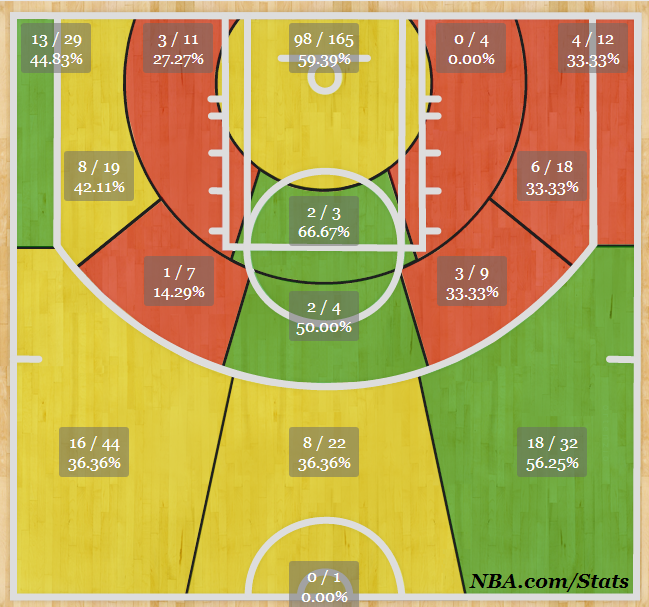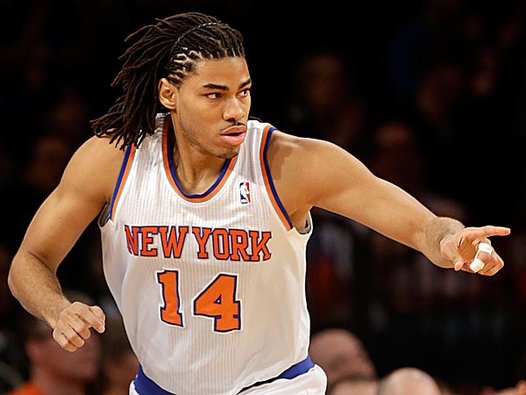The Basics
Height: 6’8″
Weight: 225
NBA Experience: 1 year (age 29)
Teams: New York Knicks, NBDL, Euro
Quick Hits
Great from deep
Decent Finisher at the rim
Defense is poor
Not clearly a power forward or small forward
High professional character
Offense
Copeland was 14th in the NBA last season in 3P% among players with at least 100 attempts, hitting 59 of his 140 attempts. This 42.1% would have made him the best Hornets long-range sniper had he played under that nickname. Taking 5.85 attempts per 36 minutes places him 7th, with Steph Curry leading the way at 7.25. So he not only makes threes at a very nice rate, but he attempts them often enough to make a big difference. Combine this with shooting two-pointers at 51.3% and 75.9% from the line, it’s clear this guy can score.
He posted a TS% of 0.583 in 862 minutes and matched Eric Gordon’s Hornets-leading points per 36 minutes, 20.3, tying for 15th in the NBA.
He does nothing else on offense, however. His assist numbers are poor, and it’s hard to bounce back from his rebounding number, even per 36 minutes. The Knicks were not a particularly strong rebounding team, but this is a theme throughout Copeland’s career.
Defense
Copeland’s defense leaves a good deal of room for improvement. His steals and blocks are low when viewed per 36 minutes, and while those are not the be-all-end-all of defensive measurement, they are not nothing. His DRtg was among the lowest on the Knicks, and they were middling in that category overall. He is slow, at least laterally, has shown poor defensive instinct, and has trouble with team defense as well, as in the case of pick and roll defense. That could be NBA jitters, of course, but it has also never been his forte.
Rebounding Rates
Cope’s rebounding rates are :
TRB%: 8.1%
ORB%: 4.5%
DRB%: 11.9%
These are about average for offensive rebounds, but he grades out below average for defensive rebounds and, therefore, overall. Being a frequent three-point shooter means many of his offensive rebounds are away from the basket, which is why he likely grades out normally there (by coincidence) compared to defensive rebounds. We could say he’s just not that big, but he’s close to Aminu’s size and weight, and Aminu is a crazy rebounder. With one year of backup minutes under his belt, it is hard to say how much of this is a product of a system that produced fewer rebounds than most NBA teams last season.
Even in the 12 games in which he played over 24 minutes, he never reached 10 total rebounds. If that persists, Copeland is a single-double kind of player.
Scoring in Detail

Notes from Chart
First, just ignore the colors.
In his 862 minutes, Chris took 380 field goal attempts. 140 were from 3, 165 were near the rim, and 75 were from in between. This shows a head, or scheme, for efficiency. The little 4/12 from the one corner could easily have been 4/11 or 5/12, both of which make that red go away . . . see why I said ignore that? Another reason is the region right next to it . . . doesn’t it deserve to a WAY greener?
His scoring rate near the basket is also very good, but the number of shots taken between those regions being just less than 20% of his shots is very noteworthy. Very.
Muy.
How He Fits
Copeland is not a clear fit on this roster. First, nothing is clear about Copeland the player, as he seems to just be a worse defending version of the typical Knick from last season. His 862 minutes give a good glimpse into his capability, but there is just not enough data to try to extrapolate much from that to the good or to the bad.
Taking his play at face value, he is a worse Ryan Anderson. He is smaller, thinner, and older than the charismatic Pelicans forward. He can nail the three and is efficient, but he can’t do much else, whereas Anderson can rebound, at least offensively.
His lack of defense would be a huge red flag given Monty’s core beliefs on basketball play, but Anderson is not exactly a fantastic defender and gets good minutes.
In the end, it’s about skill mix. If Aminu is on the team, and Copeland and Aminu share the small forward duties, the combination of extremes could work in the short term, handling the duties by committee. Without that, I’m not sure where defense at that position will come from.
Off the court, Copeland has shown tremendous determination and desire. His story is long (read this fantastic piece) and shows these qualities, along with coachability, without question. No question of fit there.
Why You Should Want to Sign Him
Copeland is an up-and-comer, at least offensively, and the team holding the restricted free agent is limited in their ability to sign the non-Bird player. These opportunities do not come up to often, so they must be considered when they arise.
Copeland could provide some additional space on offense, which may be needed against some teams. He’d be a nice change of pace rotation when Aminu is having an off night, or could provide extra offense now the Holiday is adding some backcourt defense.
Shooters are streaky. On a given night, having more shooters to work through to find the guy who might work is only an advantage.
Expected Contract
Chris Copeland reportedly wants “Steve Novak money,” or 4 year, $3.75m per year, all guaranteed. He will likely not receive this, given his age an short NBA minute-count. the Knicks, however, can offer him the tax-payer MLE, or $3,183,000 this season, even after the Kidd retirement. Thus, the deal will either have to be something the Knicks are unwilling or unable to match or include a player the Knicks would like (but perhaps not in sign-and-trade to them) while still appealing to Copeland.
The Bucks are also interested in Copeland, which complicates matters.
This leaves two routes.
1) Offer Chris 2 years, $3.5m per year, guaranteed. This will be nearly an additional $1m over what the Knicks can offer. While not as much as he wants, it gives him a chance to further prove himself. It gives the team that wants him a good chance of getting him, but forces as 2-year look.
2) Offer Chris 3 years, $2.3m per year, $1m guaranteed in 2014-2015, $0 guaranteed in 2015-2016 if waived by June 30, 2014. This is essentially Lopez’s deal divided by 2 with a little more of a guarantee. The deal is large enough to perhaps scare the Knicks away if they have a better use for the tax-payer MLE, as it leaves them only a minimum salary amount left to use in the Exception, which effectively consumes it. For Chris, it’s in the Steve Novak money region once the guarantee is factored in, and the guarantee date ensures he will not be passed around at the deadline like a fully unguaranteed player. For the Pelicans, it leaves $3.5m in cap room this season, costs $1m next at a minimum, but gives the team control in case Chris busts.
The Bucks or another interested team could thwart either deal, but are more likely to outbid the second, more strategic offer. Also, the second deal could be fend off a Knicks match by trading Rivers or Vasquez to them, if they desire, but I’m not sure the Pelicans would do that in a Copeland transaction.

9 responses to “SF Prospect: Chris Copeland”
I agree Copeland is not a clear fit. He is a slightly better version of Korver. Both are too one dimensional and too old for me. Copeland would maybe make my list as a last choice potential starter. I prefer others.
No thanks. I want Iggy or Wilson Chandler.
Absolutely no way we would trade Vasquez or Rivers to get Copeland… no way!
I live in New York, so I watched the majority if their games last season, and I have to say I really don’t like Copeland’s game. First of all, all he really gives you on offense is his shooting, but I think playing in the Knicks’ system made him look a lot better than he really is. Opposing teams couldn’t afford to leave Melo, Smith, and Chandler alone, and this resulted in many of Copeland’s threes being unguarded. His movements seem very mechanical, in other words, not fluid. He can only in a straight line, and he often just keeps his head down the entire time, not aware whether or not he has an open teammate to pass to or how the defense has adjusted, so he usually drives into trouble. is defense s really bad, as he just doesn’t have the speed or quickness like you said. All in all, if we’re going to pay Copeland, it’s going to be solely for his three point shooting, and I think there are better options out there.
I really feel like the price is right for Copeland IF we can’t land a premier SF such as Iggy. It wouldn’t be the end of the world to “tread water” with Copeland and AFA at the 3 spot and then re-address it next offseason (or at the trade deadline) as the EG10 situation becomes more resolved.
He seems like a good guy, but I would rather Darius Miller to be honest. Make miller spend the whole offseason putting up some threes, and see what he can do. No way should that cap space be wasted on Copeland.
Like the idea of a platoon at sf. With solid d at the 1 & 2, and the big easy protecting the rim behind him, we could hide Copland on d and his shooting def would help open up things on offensive end for Jeru, eg , big ez.
We could pick up a defensive specialist to complement Chris with, to play on nights when we need shutdown d at the 3
With Jrue on the roster now, we need wings that can shoot the 3. This will enable Holiday to get to the rim with ease. I can see an excellent lineup for this as:
Holiday
Vasquez
Copeland
Anderson
Davis
I wouldn’t trade any assets for him, but I wouldn’t mind a $3M a year deal.